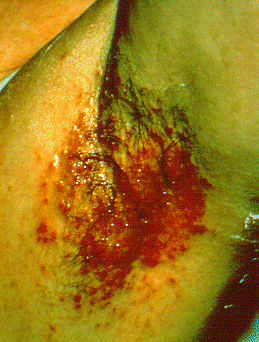Occupational Dermatoses
NOTE: This page is archived for historical purposes and is no longer being maintained or updated.
Slides 91 to 95
Slide 91 - Women in industry
This photo was removed due to privacy concerns.
More than half of American women between the ages of 18 and 65 are now employed outside the home on a full or part-time basis. This trend continues to increase. Physiologically women tend to have drier skin and slightly higher pH than men which may result in a somewhat heightened susceptibility to skin irritants. In addition, women usually have a greater exposure to irritants within the home such as cleaners, soaps, detergents and waxes which may lower the threshold of skin irritation. The reported incidence of industrial dermatitis is slightly higher in women then men.
Slide 92 - Acne prone

Acne prone workers placed in environments in which there is contact with oils frequently have poral occlusion problems. Hot humid environments may also cause sufficient hydration and swelling of the skin to predispose to acne. This worker's head was positioned in such a way as to constantly crease on side of his neck, causing recurrent deep lesions in that one location.
Slide 93 - Poor hygiene

Additional predisposing factors include poor hygiene, soiled clothing and lack of adequate washing facilities at the work site. Wearing soiled clothing in contact with the skin increases the likelihood of dermatoses.
Slide 94 - Copper smelter

Many workers, like this copper smelter, are exposed to intense heat, dust and fumes. They often develop intertriginous eruptions because of the prolonged sweating of body folds and creases.
Slide 95 - Axillary intertrigo

Axillary intertrigo is just one of the resulting changes that occur in workers who perpsire excessively and have hot work environments. A wet warm axilla can support the growth of many pathogenic bacteria, yeasts and fungi.
- Page last reviewed: January 5, 1998 (archived document)
- Content source:
- National Institute for Occupational Safety and Health Health Effects Laboratory Division (HELD)


 ShareCompartir
ShareCompartir